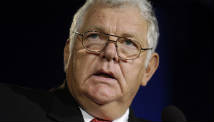STORY HIGHLIGHTS
- NEW: Iowa motorists cope with wet, heavy snow and treacherous roads
- Heavy snow, high winds stretch from Iowa to Wisconsin in the season's first blizzard
- Tens of thousands without power in Nebraska, Iowa
- Storm to crawl from Midwest to New England by Friday
Is the storm hitting near you? Share your photos and videos on CNN iReport.
(CNN) -- Does the end of the world start with a snowstorm?
Probably not, but a blizzard in the upper Midwest is proving potent enough to cut power to tens of thousands of homes and force schools to call it quits from Nebraska to southern Wisconsin Thursday -- one day ahead of the official arrival of winter and, as it happens, the predicted Mayan apocalypse.
As much as another foot of wet, heavy snow is expected in places, accompanied by winds gusting to 50 mph and blowing snow that could reduce visibility to just about zero, forecasters warn.
In Omaha, Nebraska, utility crews struggled overnight -- sometimes in near whiteout conditions -- to restore power to 38,000 customers left in the dark by the storm, according to the Omaha Public Power District. The utility urged customers to brace for slow going.
In neighboring Iowa, more than 30,000 customers were without power, most of them in the Des Moines area, according to MidAmerican Energy.
The storm -- the first blizzard of the season -- made travel treacherous throughout the region. Nebraska authorities closed much of snow-packed I-80 through the state Thursday morning as blowing snow dangerously reduced visibility.
As CNN iReporter Kevin Cavallin drove through Ames, Iowa, late Wednesday night, thick snow blanketed the roads and swirled in the frigid air.
Occasional flashes of lightning illuminated the snow-covered scene, punctuated by windy gusts of up to 40 miles per hour, as Iowa shivered under its first significant snowfall of the year.
But while the weather will make travel treacherous, Cavallin expects Iowa residents to get out and about as crews start the job of clearing the roads. "A hefty snow storm like this is not that unusual for Iowa. We get a lot of snow and a lot of wind," he said.
Fellow CNN iReporter Clarence Smith in Des Moines said it was the most snow he'd seen since 2009 -- and he warns its wet, heavy consistency is going to add to the challenges for motorists.
"I was just cleaning off my car and it is so wet, it is like plaster. It doesn't come off easily," he said. "At one point I was hitting it with a snow scraper, you can say chiseling, basically."
And while many Iowans may be cursing the weather Thursday as they slip and slide around, Smith points out that the state has enjoyed a record period without snow.
In Wisconsin, Gov. Scott Walker declared a state of emergency, put the National Guard and state patrol on standby and closed state offices to the public in 20 counties most likely to be affected by the storm. Employees were still expected to report for work.
As much as 7 inches was already on the ground Thursday morning in parts of southern Wisconsin, with as much as another foot on the way during the storm's predicted Thursday afternoon peak.
The Wisconsin State Patrol and National Weather Service urged people to avoid traveling.
Blizzard warnings were up Thursday for portions of Nebraska, Missouri, Minnesota, Illinois and Wisconsin and virtually all of Iowa. Winter storm warnings extended further into Missouri, Illinois and Wisconsin, as well as into Michigan and Indiana.
Most airports were operating normally, the FAA reported. One major exception was O'Hare International Airport in Chicago, where incoming flights were running nearly two hours behind because of high winds, the FAA said.
The storm is expected to slide over New England by Friday.
CNN's Jim Kavanagh, Jareen Imam, Laura Smith-Spark, Carma Hassan and Joe Sutton contributed to this report.












